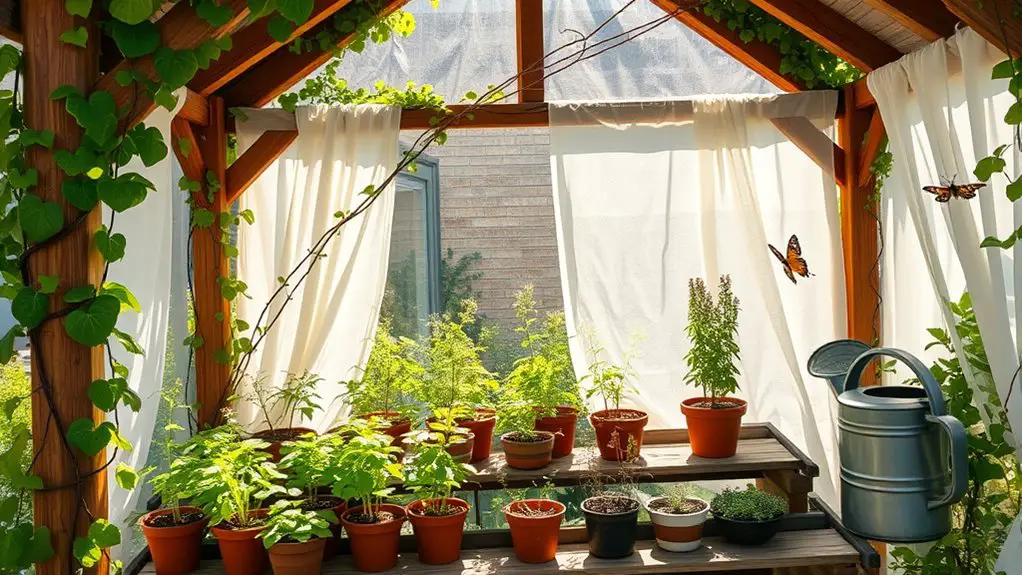To transform your gazebo into an outdoor greenhouse, first assess its sunlight exposure, aiming for at least six hours daily. Confirm proper ventilation by installing windows or vents to maintain airflow, preventing humidity buildup. Choose suitable plants, like herbs and leafy greens, to thrive in your gazebo’s environment. Use vertical gardening techniques to maximize space, and implement temperature controls to create an ideal climate. Continue exploring for more tips on maintaining a thriving gazebo greenhouse.
Assessing Your Gazebo’s Potential for Greenhouse Gardening
How can you determine if your gazebo is suitable for greenhouse gardening? First, assess the amount of gazebo sunlight it receives. Ideally, a well-positioned gazebo should capture at least six hours of direct sunlight daily, essential for photosynthesis and plant growth. Next, consider gazebo ventilation. Proper airflow is vital to prevent overheating and humidity buildup, which can harm your plants. Make sure your gazebo has sufficient openings or design features that promote air circulation. You might also consider adding fans or vents if necessary. Finally, evaluate the structure’s durability and temperature insulation, as extreme conditions can affect your gardening success. By carefully examining these factors, you can decide if your gazebo will effectively support your greenhouse gardening aspirations. Additionally, consider the structural integrity of the gazebo to ensure it can handle modifications for optimal growing conditions.
Choosing the Right Plants for Your Gazebo Greenhouse
When it comes to choosing the right plants for your gazebo greenhouse, selecting species that thrive in the unique conditions of your structure is essential. Consider plant selection based on light exposure, humidity, and temperature variations. Herbs like basil, mint, and parsley flourish in well-drained soil and moderate sunlight; they also adapt well to seasonal changes. For vibrant colors, consider flowering plants like geraniums or petunias, which can brighten your space. Seasonal considerations are vital; for instance, tomatoes and peppers prefer warmer months, while leafy greens like spinach and lettuce can handle cooler temperatures. By understanding these dynamics, you’ll create a thriving environment that allows your plants to flourish and your gardening experience to be fulfilling. Additionally, incorporating features like shade structures can enhance the growing conditions for your plants by providing protection from harsh sunlight.
Implementing Temperature and Humidity Control
Although maintaining ideal temperature and humidity levels in your gazebo greenhouse may seem challenging, it’s essential for the health of your plants. Effective temperature regulation and humidity monitoring can make a significant difference in your gardening success. Here are four strategies to implement:
Maintaining ideal temperature and humidity in your gazebo greenhouse is crucial for thriving plants and gardening success.
- Ventilation: Install windows or vents to enhance air circulation and prevent overheating.
- Thermometers and Hygrometers: Use these tools to track temperature and humidity levels accurately.
- Heating and Cooling Systems: Consider portable heaters or fans for precise climate control during extreme weather.
- Watering Techniques: Implement drip irrigation or misting systems to maintain consistent humidity levels without over-saturating the soil.
Maximizing Space With Vertical Gardening Techniques
As you look to make the most of your gazebo space, incorporating vertical gardening techniques can greatly enhance your gardening potential. By utilizing vertical planter options, like wall-mounted pockets or tiered shelving, you can increase your planting area without sacrificing precious floor space. These space-saving solutions allow you to cultivate a variety of plants, from herbs to flowering vines, efficiently. Additionally, consider using trellises or hanging planters to create a lush, green environment that maximizes sunlight exposure. This approach not only elevates your plants but also adds aesthetic appeal to your gazebo. Embracing vertical gardening can transform your outdoor greenhouse into a thriving, productive oasis, providing you with fresh produce and a sense of freedom in your gardening pursuits.
Maintaining Your Gazebo Greenhouse for Optimal Growth
To guarantee your gazebo greenhouse supports ideal plant growth, regular maintenance is essential. Keeping your environment healthy will secure vibrant plants and abundant harvests. Here are four key aspects to focus on:
- Soil Health: Regularly test and amend your soil to maintain nutrient balance, promoting optimal root development.
- Watering Schedule: Establish a consistent watering routine to prevent over- or underwatering, promoting healthy growth.
- Pest Management: Implement natural pest control strategies, like introducing beneficial insects, to minimize crop damage without harmful chemicals.
- Ventilation: Promote proper airflow to regulate temperature and humidity, vital for preventing mold and fostering a thriving ecosystem.
Frequently Asked Questions
Can I Use My Gazebo Year-Round for Gardening?
You can absolutely use your gazebo year-round for gardening! With proper gazebo insulation, it’ll become a cozy haven for your plants, letting you embrace the freedom of gardening in any season. Enjoy the endless possibilities!
What Materials Are Best for Greenhouse Gardening in a Gazebo?
For effective greenhouse gardening in your gazebo, consider using polycarbonate panels for insulation, which provide excellent light diffusion. Combine that with thermal mass materials like water barrels to maintain temperature stability and enhance your growing environment.
How Do I Protect My Plants From Pests in a Gazebo?
To protect your plants from pests, introduce natural predators like ladybugs and lacewings. Additionally, consider using organic pesticides derived from neem oil or insecticidal soap, ensuring a healthier environment for your plants and promoting biodiversity.
Is Artificial Lighting Necessary for Gazebo Greenhouse Gardening?
Imagine your plants basking in radiant sunlight; however, without sufficient natural light, artificial lighting can enhance greenhouse efficiency. It boosts growth, especially during shorter days, ensuring your plants thrive in your lovely gazebo sanctuary.
Can I Grow Vegetables and Flowers Together in My Gazebo?
Yes, you can grow vegetables and flowers together in your gazebo. Just guarantee proper plant spacing for air circulation and consider companion planting to enhance growth, deter pests, and promote a thriving garden ecosystem.

